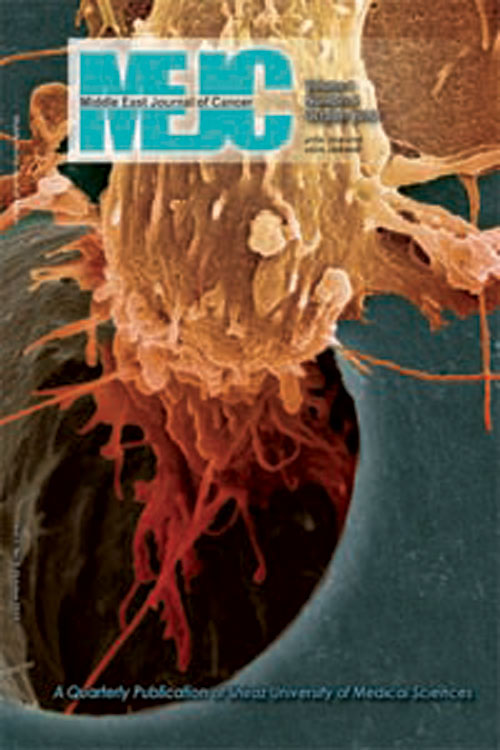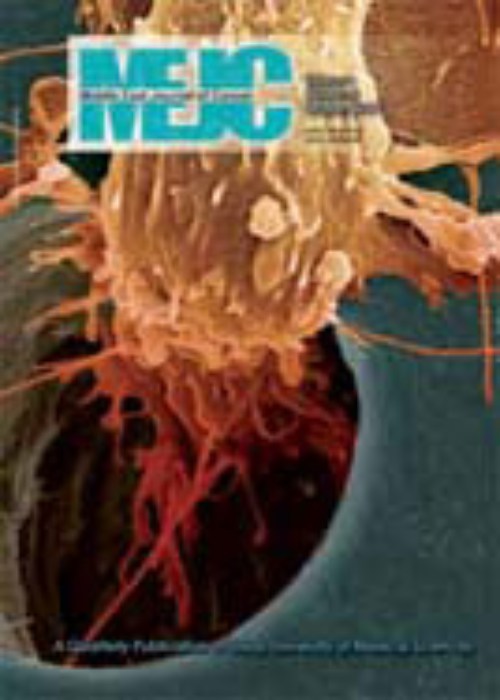فهرست مطالب

Middle East Journal of Cancer
Volume:6 Issue: 4, Oct 2015
- تاریخ انتشار: 1394/08/01
- تعداد عناوین: 8
-
-
Pages 203-209BackgroundInterleukin-19, a member of the interleukin-10 family of cytokines,contributes to breast cancer pathogenesis. High interleukin-19 expression in breasttumor tissues is associated with poor clinical outcome. This study aimed to assessthe changes in serum level of interleukin-19 in breast cancer patients in comparisonwith normal women and its association with the clinicopathological parameters ofthis disease.MethodsEnzyme-linked immunosorbent assay was used to analyze serumlevels of interleukin-19 in 116 women with breast cancer before chemotherapy orradiotherapy, and in 60 healthy age-matched women without any acute or chronicdiseases or family history of cancer.ResultsThere were significantly lower serum interleukin-19 levels in breast cancerpatients (median: 27.3 pg/ml; range: 10.5-2443.6 pg/ml) compared to healthycontrols (median: 35.1 pg/ml; range: 10.9-13676.6 pg/ml; P<0.01). Compared to the healthy control group, the decrease in serum interleukin-19 concentration was seen in all breast cancer stages. However the decrease was only significant for stage III (P=0.02). We found no significant association between serum interleukin-19 levels and stage, grade, lymph node involvement or other clinicopathological variables of the disease. However, when compared to the healthy control group, we found significantly decreased serum interleukin-19 levels in patients with involved lymph nodes (P<0.01) or tumor size greater than 2 cm (P=0.01).ConclusionThere were significantly decreased interleukin-19 levels in breastcancer patients compared to the healthy control group. We observed no associationbetween serum interleukin-19 levels and clinicopathological parameters in breastcancer patients.
-
Pages 211-218BackgroundColorectal cancer is one of the most common malignancies worldwide with more than one million new cases diagnosed each year. The aim of this study is to investigate the prevalence of herpes simplex virus and Epstein-Barr virus in patients with colorectal carcinomas and polyps in comparison with healthy subjects by using the polymerase chain reaction technique.MethodsIn this analytical case-control study, we selected 15 patients with colorectal cancer, 20 patients with colorectal polyps and 35 patients without malignancy as controls. Biopsy specimens were frozen under sterile conditions at -20ºC. After DNA extraction, analysis of polymerase chain reaction to detect herpes simplex virus and Epstein-Barr virus DNA in tissue samples was performed. Statistical analysis was performed with the χ2 test.ResultsWe observed herpes simplex DNA in 33.3% of tumor samples (5 of 15) and 20% from the non-malignant control group (7 of 35). There was no herpes simplex DNA in the polyp tissues (0 of 20). Epstein-Barr DNA was found in 60% of tumor samples (9 of 15), 35% of polyp samples (7 of 20), and 40% of the non-malignant control group (14 of 35). Statistical analysis showed no significant association between the prevalence of herpes simplex and Epstein- Barr viruses and the incidence of colorectal cancer and polyps compared with the control group.ConclusionThe results demonstrate a lack of direct molecular evidence to support an association between herpes simplex and Epstein-Barr viruses with human colorectal malignancies. These results do not exclude a possible oncogenic role of these viruses to infect different colon cells.
-
Pages 219-228BackgroundToday’s healthcare organizations are challenged by pressures to meet growing population demands and enhance community health through improving service quality. Quality function deployment is one of the widely-used customer- driven approaches for health services development. In the current study, quality function deployment is used to improve the quality of chemotherapy unit services.MethodsFirst, we identified chemotherapy outpatient unit patients as chemotherapy unit customers. Then, the Delphi technique and component factor analysis with orthogonal rotation was employed to determine their expectations. Thereafter, data envelopment analysis was performed to specify user priorities. We determined the relationships between patients’ expectations and service elements through expert group consensus using the Delphi method and the relationships between service elements by Pearson correlation. Finally, simple and compound priorities of the service elements were derived by matrix calculation.ResultsChemotherapy unit patients had four main expectations: access, suitable hotel services, satisfactory and effective relationships, and clinical services. The chemotherapy unit has six key service elements of equipment, materials, human resources, physical space, basic facilities, and communication and training. There were four-level relationships between the patients’ expectations and service elements, with mostly significant correlations between service elements. According to the findings, the functional group of basic facilities was the most critical factor, followed by materials.ConclusionThe findings of the current study can be a general guideline as well as a scientific, structured framework for chemotherapy unit decision makers in order to improve chemotherapy unit services.
-
Pages 229-235BackgroundDespite the impressive results obtained with imatinib, inadequate response or resistance are observed in certain patients. It is known that imatinib is a substrate of a multidrug resistance gene (MDR1). Thus, interindividual genetic differences linked to single nucleotide polymorphisms in MDR1 may influence the metabolism of imatinib. The present study has aimed to examine the impact of MDR1 polymorphisms on the hematologic and cytogenetic responses in 70 chronic myeloid leukemia patients who received imatinib.MethodsWe used a polymerase chain reaction followed by restriction fragment length polymorphism to identify different profiles of 1236C>T, 2677G>T and 3435C>T in MDR1.ResultsThe distribution of the three SNPs in responders and poor responders did not show any particular trend (P>0.05). The T allele was slightly higher in responders, but not significantly regardless of the type of SNP (40.3% vs. 33.8% for 1236C>T; 25% vs. 14.7% for 2677G>T and 33.3% vs. 22% for 3435C>T). The dominant model showed a similar trend (P>0.05). Diplotypes composed by the T allele in different exons were frequent in responders. Haplotype analysis showed that 1236C-2677G-3435C was slightly higher in poor responders (60.02%) compared to responders (50.42%). However, 1236T-2677T-3435T was frequent in responders (16.98%) compared to poor responders (13.1%). Overall, none of the haplotypes were associated with IM response in our cohort (global haplotype association test, P=0.39).ConclusionThe identification of 1236C>T, 2677G>T and 3435C>T polymorphisms may not be advantageous to predict imatinib response for our chronic myeloid leukemia patients.
-
Pages 237-241BackgroundColorectal cancer is one of the most common malignancies worldwide with more than one million new cases. According to the Ministry of Health and Medical Education of Iran, colorectal cancer is the third most common cancer in Iran. Many risk factors are known causes of this disease. However, the molecular mechanisms associated with colorectal cancer are still under investigation. Recent studies have shown that some viruses, particularly human papilloma virus, may be associated with the pathology of colorectal cancer.MethodsThis case-control study examined 95 colorectal cancer and 95 normal colon tissue paraffin blocks (control) to identify the relationship between human papilloma virus and colorectal cancer by polymerase chain reaction.ResultsClinicopathological data that included sex, age, tumor grade, stage and location were recorded. All tumor and control groups (totally: 190 samples) were negative in terms of the human papilloma virus genome. No relationship between clinico- pathological data and human papilloma virus genome was identified.ConclusionsRegardless of other risk factors for colorectal cancer, a number of studies in different parts of the world have shown that human papilloma virus may be an important factor in the increasing incidence of colorectal cancer. However, we have found no association between human papilloma virus and colorectal cancer in this study.
-
Pages 243-251BackgroundScreening mammography is an established intervention that leads to early breast cancer detection and reduced mortality. The Lebanese Ministry of Health has initiated yearly awareness campaigns and provided free mammography in multiple centers around the country.MethodsThe study took place in two major areas of Lebanon - Beirut and South Lebanon. This cross-sectional survey aimed to assess knowledge about breast cancer screening and screening behaviors in the Lebanese population. The primary outcome of the study was to assess the reasons that prevented women from performing screening mammography based on our categories of questions: lack of knowledge about breast cancer, lack of access to screening facilities, failure of primary care physician to encourage screening behavior, and other reasons.ResultsThe major barriers to seek screening that had statistically significant P-values, in order of prevalence, included: lack of knowledge about breast cancer, followed by social reasons and lack of access.ConclusionGiven the prevalence of breast cancer in our population, it is important to understand the pitfalls that we experience in promoting awareness. Our study is the first study to reach out to the community to assess perceived barriers against screening and provide solutions for such barriers.
-
Pages 253-265BackgroundRecent epidemiological studies demonstrate that obesity is associated with an increased risk for breast cancer in women. Increased estrogen levels are suggested as one possible explanation, but this does not fully explain the relationship between obesity and breast cancer. One alternative explanation is secretion by adipocytes of metabolites, hormones and cytokines, collectively known as adipocytokines, which regulate physiological and pathological processes. Among these adipokines are visfatin and resistin. This study investigates whether visfatin or resistin in serum of breast cancer patients can be used as potential diagnostic and prognostic tools for breast cancer, taking into account clinicopathological features and anthropometric parameters.MethodsBlood samples were collected from 70 breast cancer patients (35 obese and 35 non-obese) and 20 healthy females matched for age and body mass index as the control group. Serum visfatin levels were measured by enzyme linked immunosorbent assay and serum resistin levels were measured by radioimmunoassay. Inflammatory status was assessed by measuring C-reactive protein levels by an automated turbidimetric analyzer.ResultsWe observed highly elevated serum resistin and visfatin levels in breast cancer patients compared to controls, independent of body mass index. Serum resistin and visfatin levels were likely to be associated with increased breast cancer risk and correlated with the inflammatory marker C-reactive protein.ConclusionTargeting resistin and visfatin inhibition can be an effective therapeutic strategy in breast cancer by downregulating the inflammatory microenvironment in breast tissue. Serum visfatin promises to be a novel biomarker of diagnostic and prognostic value. Larger prospective studies are required to confirm our findings.
-
Pages 267-273BackgroundPhyllodes tumors are uncommon neoplasms of the breast. Data about their outcome is limited. This study aims to evaluate patients diagnosed with phyllodes tumors in terms of local recurrence, distant metastasis and overall survival.MethodsWe retrospectively reviewed the medical records of 129 women with phyllodes tumors who referred to our center from 1999 to 2013. Clinical and pathological features, local and regional recurrence, distant metastasis and overall survival were determined. SPSS 15.0 statistical software was used for analysis.ResultsMean patient age was 39 years (17-67 years). Mean size of the tumor was 5.38 cm. There were 105 (81.4%) benign, 8 (6.2%) borderline and 16 (12.4%) malignant tumors. The mean follow-up period of patients was 28 months (6 to 128 months). The rate of local recurrence among benign tumors was 3.8% (4 cases); in borderline cases the rate was 12.5% (1 case) and for malignant cases, it was 18.7% (3 cases). Three patients each recurred twice and one patient had local recurrence for a third time. Two patients died of malignant tumor-related disease - one due to advanced regional recurrence and lung metastasis, and the other to wide-spread metastasis. Another patient died from an unrelated cause (myocardial infarction) one year after surgery. For those with malignant phyllodes tumors, the five-year overall survival was 77.8% and disease-free survival rate was 85.7%.ConclusionAlthough, the prognosis for phyllodes tumors is good, the malignancy rate is higher in older patients and those with larger tumors. A higher local recurrence rate in malignant phyllodes tumors suggests the importance for adequate resection of margins in surgical management of these tumors.


